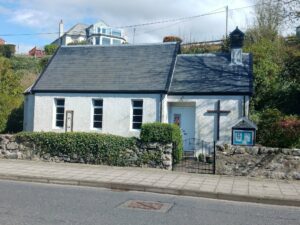St Ninian’s church is situated in a picturesque location within Portpatrick, the jewel in the crown of Dumfries and Galloway, with a permanent population of 620 in 2008, rising in excess of one thousand two hundred during the holiday season.

The area attracts a large number of holidaymakers and Portpatrick sets out to provide attractions for them. Attendance at Sunday services averages about 18 to 20 and this is boosted by holidaymakers, some of whom return regularly over the months and also year after year.
The congregation is friendly and welcoming, a point which is often remarked upon by visitors. Indeed, many visitors comment upon the peace and tranquillity of the church itself. It is hoped that we may, in due course, organize a rota to allow the church to be open for visitors for a short time on Saturdays during holiday periods.
St Ninian
The first Christian historical figure who might be identified in Scotland is St Ninian, although what is known of his early life points to pre-existing Christian Church. He is thought to have been born in Galloway around 350 and have been baptised young.
The story about him says that as he grew into faith he travelled to Rome and was welcomed by Pope Damasus (366-384). Eventually he was consecrated a Bishop for his native land by Pope Siricius and returned to build a Church at Whithorn in Galloway around 397. Fourteen years later, the Roman legions finally withdrew from Britain.
Ninian is said to have travelled across Scotland with the message of Jesus. Many place names in south-western and central Scotland are associated with him and an east coast journey can be traced through Arbirlot in Angus, Dunnottar in Kincardineshire, the Ythan valley near Ellon, to Glenurquhart and Caithness and on to Orkney and Shetland.
St Ninian possibly died at Whithorn in 432, the same year that Patrick landed in Ireland to begin his missionary work. Ninian’s work was continued by Palladius, Surf and Ternan, but generally the turmoil that followed the Roman withdrawal was detrimental to the young church and there was considerable falling away.
Year by year, decade by decade, century by century, the Church has changed. The years ahead will be no exception, but all will be well if the Church continues to hold fast to its love of God and concern for the people of this nation. The love that was there for Ninian, Columba, and the early Saints has not changed.
God continues to guide those who seek to walk in God’s ways.
Pray that the Scottish Episcopal Church will do this in partnership with the other Churches of this land in the years ahead.
